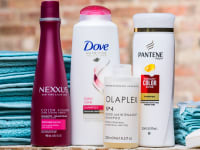Does Overtone’s trendy hair color work on dark hair?
The coloring conditioner looks great on Instagram.
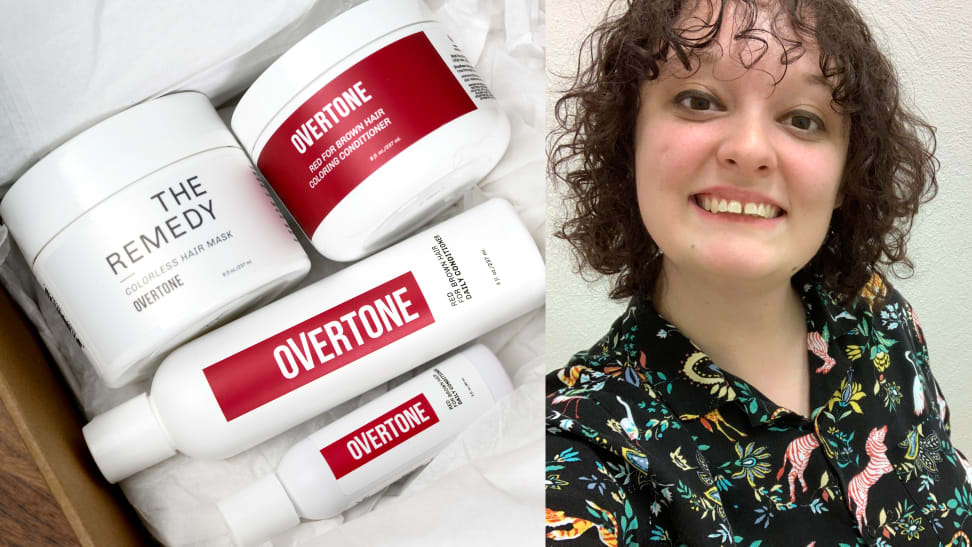 Credit:
Reviewed / Betsey Goldwasser / Melissa Rorech
Credit:
Reviewed / Betsey Goldwasser / Melissa Rorech
Products are chosen independently by our editors. Purchases made through our links may earn us a commission.
We at Reviewed are just as curious about those flashy products we see in our Instagram feeds as you are. For our ‘As Seen On IG’ series, our writers put them through their paces to find out if they’re actually as good as they look online—or too good to be true. Spot one that we’ve missed? Email us at [email protected].
Most people have at least one moment in their lives where they want to dye their hair. Sometimes you’re feeling wild, or you just need a change. If you have naturally lighter hair, it’s easier to tint it any color you’d like. But if you’ve got dark locks like I do, it’s not as easy. To get a lighter or bright color to show up, you typically must first strip out your natural shade with strong bleach—permanently damaging your hair. If only there was a way to dye your hair without having to bleach it first…
In comes Overtone Haircare—specifically the brand’s For Brown Hair products—which claim to do just that. This means that you, at home, with any shade of brown hair—light, medium, dark, whatever!—can dye your own hair a variety of different crazy colors, without having to spend a fortune at the salon and without damaging your hair with bleach first. At least, that’s the promise.
I first saw Overtone advertised on Instagram, then on Facebook, then heard friends mention it, and suddenly it was everywhere. With more than 540K followers on Instagram, I wondered, “is this too good to be true?” Everyone I knew with brown hair was curious about this product, but too scared to try it themselves because it was so new and mysterious. Lucky for them, I decided to take one for the brunette team and test Overtone’s Red For Brown Hair kit to see if it was as miraculous as it claims.
What makes Overtone different from other hair dyes?
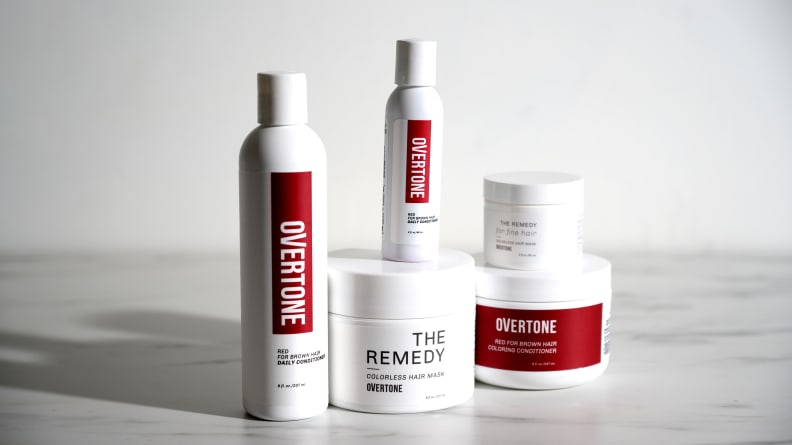
I purchased the Red for Brown Hair Complete Kit from Overtone, along with their new product The Remedy, a colorless hair mask.
Unlike one-time-use permanent dyes that last until you chemically remove them or cut the hair off, Overtone products are not dyes—they’re pigmented conditioners. Permanent dyes require developers that are meant to forcibly open your hair cuticles and insert the color, but Overtone claims its color absorbs into your strands when applied under hot water, and that this is possible because your hair cuticle is already somewhat open “unless you've never blow-dried, been in the sun, or used shampoo.” It’s also not meant to be a one-time application; it is designed for regular use— as often as you wash your hair “so your color is perfect every single day.”
You may wonder how this is different from a semi-permanent color (sometimes called a gloss), which coats the hair’s cuticle and only lasts a few weeks before fading. Overtone's answer is that its products are free of ingredients like peroxide, ammonia, and “heavy” alcohols that typical dyes (even some semi-permanent ones) can include. There are semi-permanent hair colors that also do not include those ingredients, such as DP Hue's glosses, but Overtone brands itself as a non-dye, possibly because dyes of any kind have a negative connotation when it comes to hair health. However, semi-permanent color is not “bad” for your hair at all, as Overtone suggests, according to professional stylist Shan Casey, the owner of Boston-based hair salon Shan Hair. “Permanent color changes the cuticle—it’s going to open it and it’s going to force pigment into the hair shaft. That’s a little, tiny bit of damage,” Casey says. “[But] semi-permanent literally does sit on the hair shaft and companies like Goldwell put lipids in there that actually improve the hair by giving it some moisture and helping shut the cuticle down.”
What’s more, Overtone might even not be temporary. In an article on its website titled “How Long Does Overtone Last?,” it says, “Results can range from washes-out-in-a-week to never-coming-out-completely-without-bleach.”
To think that this might change the shade of my hair forever—rather than give it a quick, fun, temporary jolt of color—was concerning. I found a bunch of articles and videos online of people praising Overtone for how great it was and how quickly it worked for them, but none of them talked about how quickly it went away or if it faded away.
How do you use Overtone?
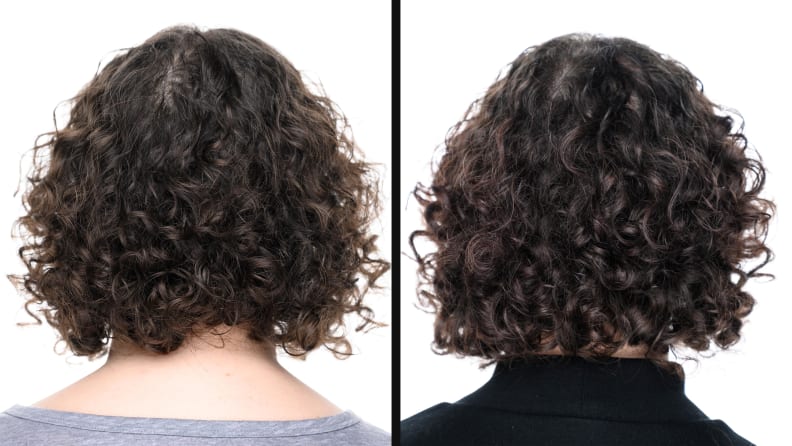
On the left was my hair before Overtone and on the right was my hair after doing the initial Coloring Conditioner and Daily Conditioner.
When you purchase Overtone’s Healthy Color Duo, you receive a Coloring Conditioner, the most pigmented formula, for one-time use and a Daily Conditioner that replaces pigment lost in the shower, which should last you at least 20 conditioning sessions.
When my Red for Brown Hair Healthy Color Duo arrived, I began with the Coloring Conditioner to apply color the first time. Upon opening the jar of “red” Coloring Conditioner—which was advertised as a red wine, maroon-esque color once on the hair—I was a little taken aback to see it was a bright blood orange mixture. I figured this meant that I needed a bold color in order to properly dye my dark brown hair, which I’ve only ever highlighted or dyed the tips of (and that was two years ago). To achieve maximum color, the directions said to apply to clean, dry hair.
Wearing gloves, I started with a “strand test” like the instructions suggested, in which I pulled a piece of hair from the back of my head and put some dye on it to test out the color. But then I remembered I was dyeing my hair to write this review so I needed to finish the task, no matter what it looked like. I went in, applying it to all of my hair, section by section. I used hair ties to corral my curly locks into smaller similar-sized sections and applied the Coloring Conditioner to one side of my head first before moving onto the next. I left it on for about 30 minutes—slightly longer than the 10-15 time recommended, for good measure.
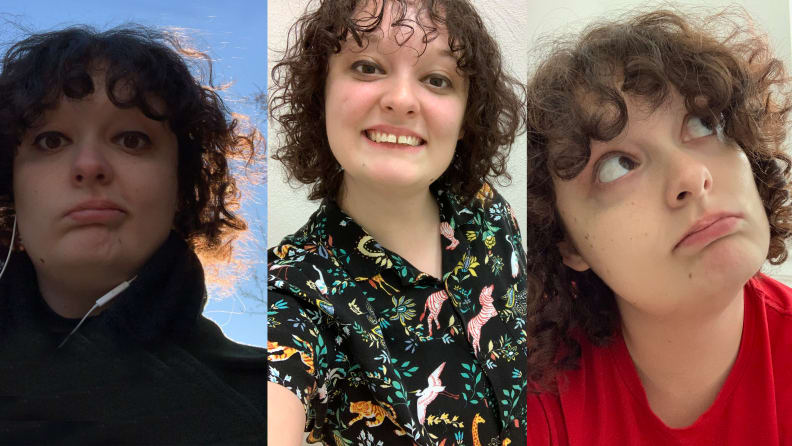
The first picture was taken the day after the initial dye, 2nd picture was several days into using Daily Conditioner, and 3rd picture was immediately after using the Coloring Conditioner.
Finally, I hopped in the shower to “rinse my hair thoroughly with warm or hot water,” as the instructions said to do. The water turned bright orange and I learned fast that this process would not be a clean one, as my shower and shower curtain got stained. I rinsed my hair until the water ran clear, which is how I interpreted “thoroughly,” as there was no guidance otherwise.
When I stepped out of the shower and looked in the mirror, my hair looked just as dark brown as it had been before. After drying off and diffusing my curls with my blow dryer, I realized there were a lot of red stains on my scalp, ears, neck, and forehead—but not a single inkling of red tone to be seen on my hair itself. Disappointing, to say the least. Still, it was only the first day, so I figured maybe it would develop with additional treatments.
I used the Daily Conditioner every day for a week after that, which also required gloves because it, too, is pigmented. The Daily Conditioner only advised to leave it on for about three to five minutes, but since I was still eager to get some red out of this, I would leave it on for 10 minutes some nights—which was a huge time investment. Eventually, I stopped rinsing once it seemed like I was at the halfway point, so the water wouldn’t run clear and I knew there would still be some color in my hair when I got out. I kept up this process of Daily Conditioner and weekly Coloring Conditioner for a month straight. The good news: This didn’t stain my towels or pillowcases. The bad news: It didn’t stain my hair, either.
Does Overtone For Brown Hair work?
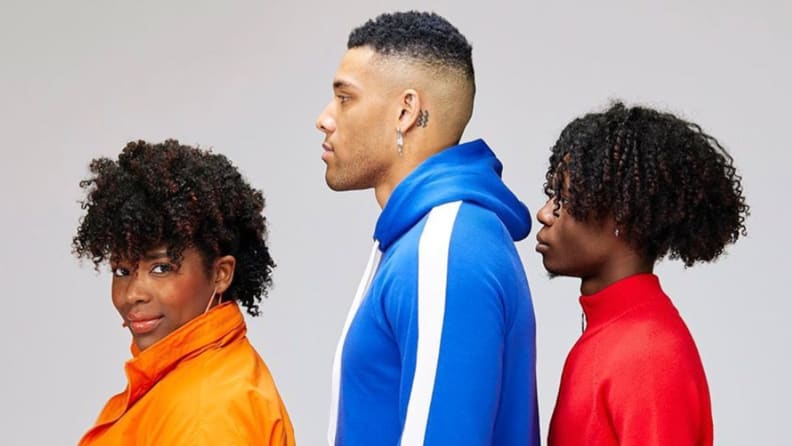
If the Overtone models weren't wearing tops that correspond with their hair color, you likely would only see dark hair.
For me, take a guess. In fact, there were many times throughout that month where I’d tell someone, “I dyed my hair red last night,” and they’d either laugh like I was pulling a fast one on them, or look very confused. Then I’d show them a bad selfie of me from the night prior with my head covered in red dye, and they’d be even more befuddled. Some coworkers said that if the sun hit my hair in the right light from behind, you could kind of see a tint of red glow, but only for a second. Not worth all the time and money put into this.
To be fair, I could have expected it. Overtone states in the fine print across its site things like, “Final color results can vary depending on starting hair color” or “if you have black hair, color will not show up at all.” (My hair isn’t black, but it is pretty dark brown.) Remember how I was worried about it not coming out of my hair? Well, that wasn’t really a concern of mine by the end because I barely got any pigment in my hair, so once I stopped using the product, any slight tint there quickly disappeared.
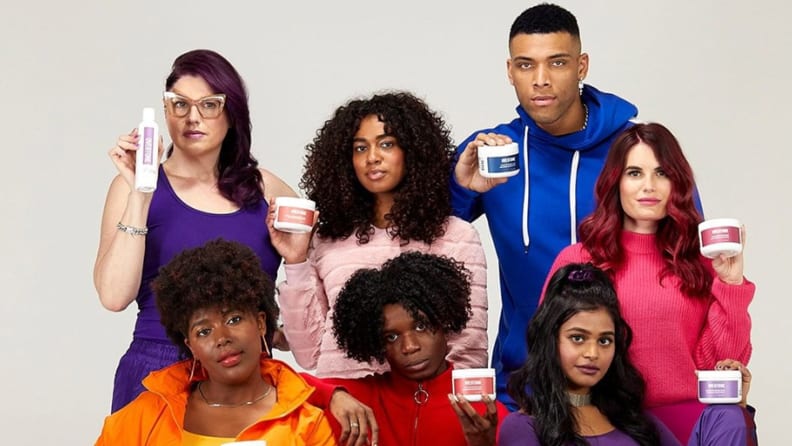
Without a colored background, you can see that many models don't seem to have much color in their dark hair. The pink, red, and purple models specifically aren't featured much on the site probably for this reason.
Another thing I noticed with further scrutiny: Overtone’s marketing can be very misleading. Most of the dark-haired models for the “For Brown Hair” collection on the “after” photos are put in a red shirt or in front of a red background (or whatever hair color they’re modeling) so it seems as though their hair is more red than it actually is. It was hard to find photos of these models on just plain white backgrounds, and almost impossible to find them wearing something that isn’t the same color as what their hair should theoretically be. Based on the ads, your eyes may trick you into thinking you see the hair color even when it’s barely there—but it’s harder to fool yourself in real life.
Does Overtone work on lighter-colored hair?
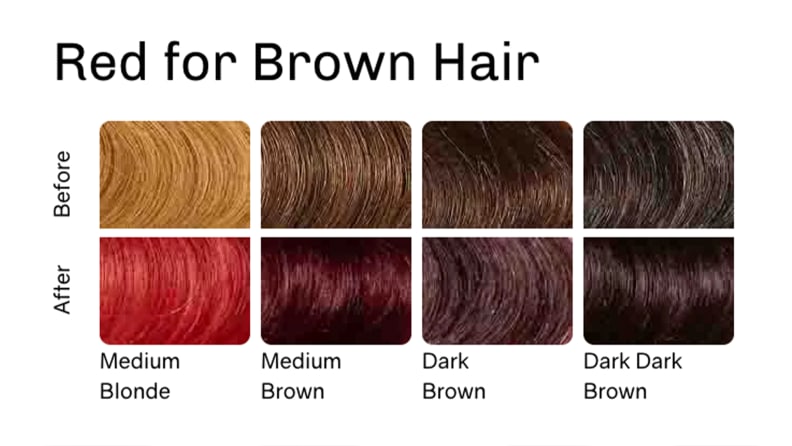
Here you can see the "expected color chart" of Red for Brown Hair. Doesn't really seem to work on Brown Hair, does it?
You get it by now: I have dark brown hair, and even though Overtone led me to believe its product would do something for me, it barely did anything at all. I don’t believe Overtone is worth it for me. But what about for you? You may have hair that’s brown or blond or ginger—or maybe already bleached and ready to be any color you want—and you probably want to know how Overtone will affect you, right? Of course you do. I got your back.
I went on Amazon to order some human hair in a range of shades from blond to black to test how the hair dye I’d been using would look on other hair colors. This test was, to be fair, a little odd. Lining up a bunch of hair, hanging them off the side of a table, and slathering Overtone all over them? Not something I’d ever pictured doing in my day job, but, hey, just another day here at Reviewed! After applying, I waited 10 to 15 minutes as the directions say, then washed off all the strands of hair and let them dry overnight.
The next morning, we took a look at how they came out. I realized my hair color fell somewhere toward the darkest three samples, which (as I’d expected) only got a small bit of color, if any. But the blond and light brown hair turned out a lot brighter—the final results resembled a blood orange, reddish color on the lighter swatches and a deeper red on darker ones. Hopefully this little test can help you compare your hair to one of these before strands and see what it would look like on you afterwards.
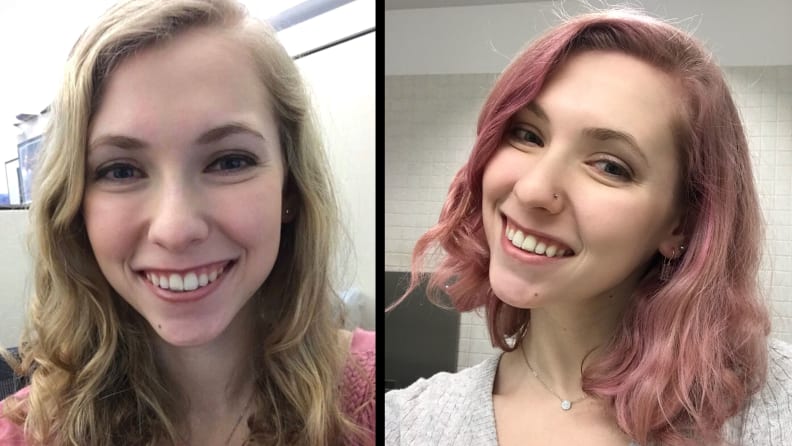
Overtone works a lot better on folks with lighter hair, as seen here.
Rachel Lipson, a Boston-area student/singer-songwriter I follow on Instagram, tried Overtone, too. She has naturally blond hair and used the Pastel Magenta Healthy Color Duo, which resulted in a bubblegum pink color—unsurprising, because her hair is a much lighter shade than mine. When asked about her experience, Lipson said, “I decided to try Overtone because it seemed like it would require less maintenance than other semi-permanent dyes I've tried in the past. It's been working out really well for me so far! I like that the magenta is light enough to show variations in the color where my natural highlights are.”
Should you try Overtone?
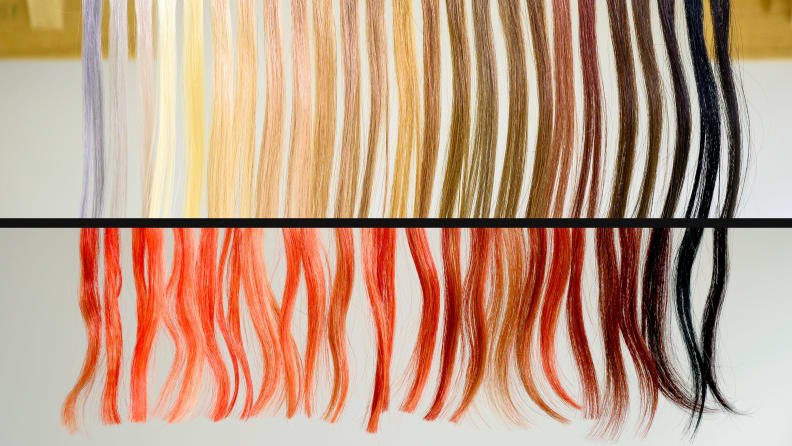
If you're curious how Overtone's Red for Brown Hair will affect your hair, here's how it came out on our tester hair.
If you have dark brown hair like me, I’d say not to bother. But if you have light brown hair or blond hair or anywhere in between, I think Overtone will work just fine for you. I mean, it is quarantine after all—why not hop on the hair dyeing train?


